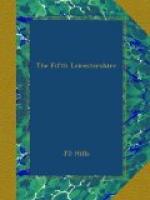The reason for this delay in the communication of orders was that our telephones were in a state of transition. We had discovered that the Boche with his listening sets could overhear all conversations carried on by the ordinary field telephone, and consequently it was absolutely forbidden to use this instrument, except in emergency, within 2,000 yards of the front line. A new instrument, the “Fullerphone,” was being introduced which could not be overheard, but one could not use it for talking; all messages had to be “buzzed.” Incidentally the “buzzing” process produced a continuous whining noise, and this, in a small Company Headquarter dug-out, was almost enough to drive the unhappy Company Commander off his head. The Fullerphone, too, was very scarce at first, so that almost all messages had to be sent by orderly, or runner as he now began to be called. This caused so much trouble that the next stage was the introduction of codes and code names. At first these were very simple, we were “John” after Col. Jones, the 5th Lincolnshires “Sand,” from Sandall, etc., while “gas” became the innocent “Gertie,” and to attack was “to tickle.” One very famous message was sent when an expected gas attack had to be suddenly postponed—“John can sleep quiet to-night, Gertie will not tickle.” Later we became “Sceptre,” when all units in the Division were called after race-horses, and still later, when Brigade Headquarters became “Girl,” we each had a lady’s name; we were “Gertrude.” It sounded somewhat curious to hear a Staff Captain who had lost his Brigadier ringing up a Battalion Headquarters to ask “have you seen a ‘Girl’ about anywhere?” The “Bab” code was also introduced, a three-figure code with innumerable permutations and combinations. The whole thing was very secret, and added much to the worries of the Company Commander, who not only had to be careful not to lose the code book, but had to remember, without writing it down, the Corps code letter and number for the week.
In the same way the Artillery had all manner of codes for every conceivable occasion. Various messages were devised and entered in the Defence Scheme for retaliation, S.O.S., raid purposes, etc., and woe betide the luckless F.O.O. or Infantryman who sent the wrong message. There were “concentrates” and “Test concentrates,” and “attacks” and “Test attacks,” and “S.O.S.” and many others. If anything serious really happened, the lines were always broken at once, and there remained only the rockets and coloured lights. The S.O.S. signal was almost sacred, not to be used for a hostile raid, or when retaliation was needed, but only in the event of the enemy massing for a general attack. However, it was once used—in a rather curious little battle fought on the 4th August, 1916.




